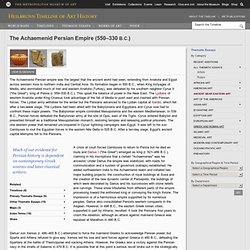

Ancient Roman History Timeline. Provides a chronological index of the history of Ancient Rome with extensive links to internet resources.

Emphasis is placed upon the use of primary source material, numismatics, and a focus upon the roles of women in ancient time. scroll down for the timeline Thank you for visiting! Timeline Menu Ridley Scott's GLADIATOR is a great film. Is it great history? Click here to learn the real story behind the events and characters portrayed in the movie. Kindly report any suggestions, problems, errors, or dead links by emailing david(at)exovedate.com Using info from this site? For detailed copyright information and bibliographic citation, click here.
The Achaemenid Persian Empire (550–330 B.C.) The Achaemenid Persian empire was the largest that the ancient world had seen, extending from Anatolia and Egypt across western Asia to northern India and Central Asia.

Its formation began in 550 B.C., when King Astyages of Media, who dominated much of Iran and eastern Anatolia (Turkey), was defeated by his southern neighbor Cyrus II ("the Great"), king of Persia (r. 559–530 B.C.). This upset the balance of power in the Near East. The Lydians of western Anatolia under King Croesus took advantage of the fall of Media to push east and clashed with Persian forces. The Lydian army withdrew for the winter but the Persians advanced to the Lydian capital at Sardis, which fell after a two-week siege. The Lydians had been allied with the Babylonians and Egyptians and Cyrus now had to confront these major powers.
Darius' son Xerxes (r. 486–465 B.C.) attempted to force the mainland Greeks to acknowledge Persian power, but Sparta and Athens refused to give way. History of Iran: Achaemenid Empire. Achaemenid Empire By 546 BCE, Cyrus the Great had defeated Croesus, the Lydian king of fabled wealth, and had secured control of the Aegean coast of Asia Minor, Armenia, and the Greek colonies along the Levant.

Moving east, he took Parthia (land of the Arsacids, not to be confused with Parsa, which was to the southwest), Chorasmis, and Bactria. He besieged and captured Babylon in 539 and released the Jews who had been held captive there, thus earning his immortalization in the Book of Isaiah. When he died in 529, Cyrus's kingdom extended as far east as the Hindu Kush in present-day Afghanistan. His successors were less successful. The Achaemenids thereafter consolidated areas firmly under their control. The quality of the Achaemenids as rulers began to disintegrate, however, after the death of Darius in 486 BCE. The Achaemenids were enlightened despots who allowed a certain amount of regional autonomy in the form of the satrapy system.
See Also Achaemenid Army Royal Road, 5th century BCE. Ancient History Encyclopedia.